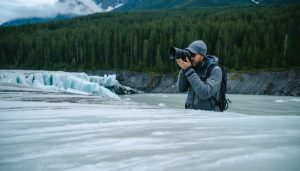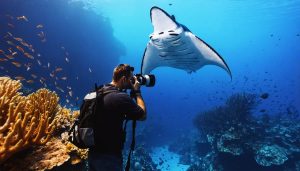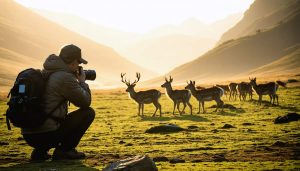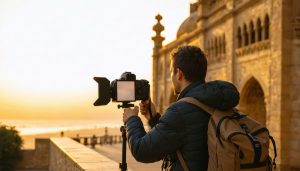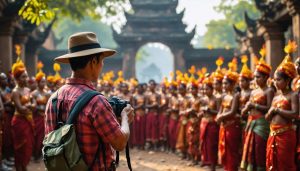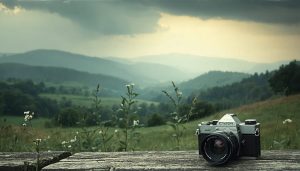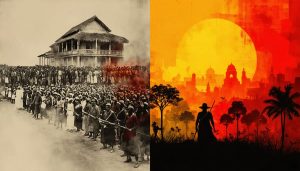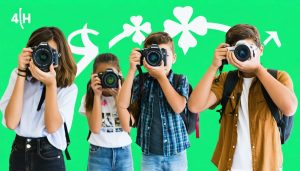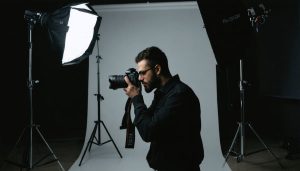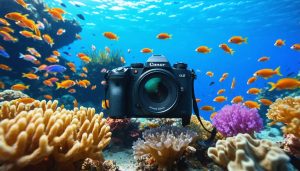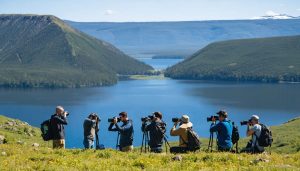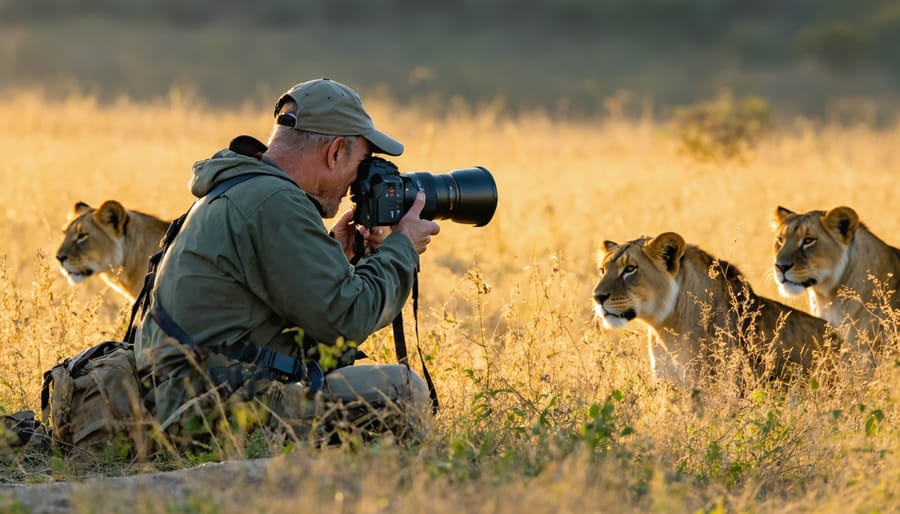
Wildlife photography captures the raw essence of nature, documenting untamed animals in their natural habitats through skilled camera work and patient observation. Far more than just pointing a camera at animals, it represents a delicate balance of technical expertise, artistic vision, and deep respect for the natural world. This specialized form of photography requires photographers to understand animal behavior, master advanced camera techniques, and often brave challenging conditions to capture authentic moments in the wild.
Professional wildlife photographers distinguish themselves by their commitment to ethical practices, ensuring minimal disruption to their subjects while creating images that educate and inspire conservation efforts. Whether photographing a pride of lions in the Serengeti or documenting endangered species in local forests, wildlife photography serves as a powerful tool for environmental awareness, scientific research, and the preservation of our planet’s biodiversity.
The field has evolved significantly with modern technology, yet its core principle remains unchanged: to reveal the beauty, behavior, and vulnerability of wild animals in their natural environments. This art form demands not only technical proficiency with camera equipment but also extensive knowledge of animal habits, weather patterns, and ecosystem dynamics, making it one of photography’s most challenging and rewarding specialties.
What Makes Wildlife Photography Unique
Technical Requirements
To excel in photographing wildlife in natural habitats, you’ll need specialized equipment and technical skills. A DSLR or mirrorless camera with fast autofocus capabilities is essential, paired with telephoto lenses (typically 300mm to 600mm) to maintain safe distances from animals. Image stabilization, either in-lens or in-camera, helps combat camera shake when shooting with long focal lengths.
High-speed continuous shooting (burst mode) is crucial for capturing fleeting moments, while good low-light performance is necessary for dawn and dusk photography. Weather-sealed equipment protects your gear in challenging conditions. A sturdy tripod with a gimbal head provides stability for heavy lens combinations.
Technical proficiency in manual exposure settings is vital. Understanding how to balance shutter speed (typically 1/1000th second or faster for moving subjects), aperture (often f/4 to f/8 for adequate depth of field), and ISO is fundamental. Mastering back-button focus and various autofocus modes helps track moving subjects effectively. Knowledge of animal behavior and fieldcraft techniques complements these technical requirements, enabling you to anticipate and capture meaningful moments.
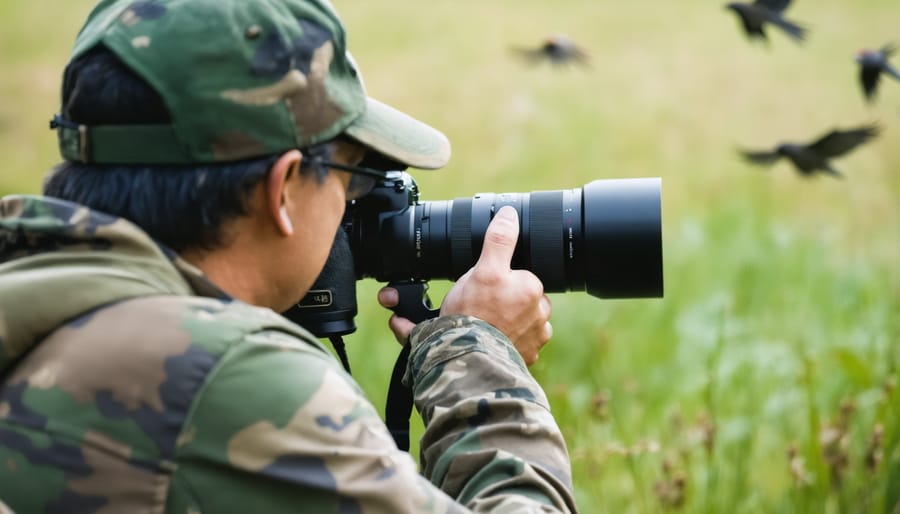
Ethical Considerations
Wildlife photography comes with significant ethical responsibilities that every photographer must consider. The primary rule is to prioritize the well-being of animals over getting the perfect shot. This means maintaining a safe distance that doesn’t disturb natural behaviors or cause stress to the subjects.
Responsible wildlife photographers follow the “leave no trace” principle, ensuring their presence doesn’t impact the natural environment. This includes staying on designated paths, avoiding baiting or luring animals, and never manipulating the scene for a better photograph. During breeding seasons or around young animals, extra caution is necessary as these are particularly sensitive times.
Understanding and respecting local wildlife regulations is crucial. Many locations require permits or have specific guidelines about approaching wildlife. Flash photography should be avoided with most animals, as it can disorient them and disrupt their natural behaviors. Similarly, drone usage should follow strict guidelines to prevent disturbing wildlife, especially birds.
Ethical considerations also extend to post-processing. While basic editing is acceptable, photographers should maintain authenticity in their images. Misrepresenting animal behavior or locations can lead to harmful consequences for both wildlife and ecosystems. Additionally, sharing location data of sensitive species should be carefully considered to prevent overcrowding or harassment of animals by other photographers.
By following these ethical guidelines, wildlife photographers contribute to conservation efforts while creating compelling images that inspire others to appreciate and protect our natural world.
The Conservation Connection
Documentation and Research
Wildlife photography serves as a vital tool in scientific research and conservation efforts, providing researchers with valuable visual documentation of species behavior, population dynamics, and habitat conditions. These images often become crucial evidence in scientific studies, helping researchers track changes in animal populations, monitor endangered species, and document previously unknown behaviors.
Through systematic photographic documentation, scientists can gather data about migration patterns, breeding behaviors, and species distribution without disturbing natural habitats. For instance, camera trap photography has revolutionized wildlife research by capturing rare and elusive species in their natural environment, providing unprecedented insights into their activities and behaviors.
These visual records also play a significant role in species identification and classification. Detailed photographs can reveal subtle physical characteristics and variations within species, aiding taxonomists in their work. In some cases, wildlife photographs have even led to the discovery of new species or subspecies.
Moreover, wildlife photographs serve as important historical records, allowing scientists to track environmental changes and species adaptation over time. When combined with modern technologies like AI and machine learning, these images can be analyzed to identify individuals within populations, estimate population sizes, and monitor the health of ecosystems.
For conservation efforts, such documentation provides compelling evidence of habitat destruction, human-wildlife conflict, and the impacts of climate change, helping to inform policy decisions and conservation strategies.
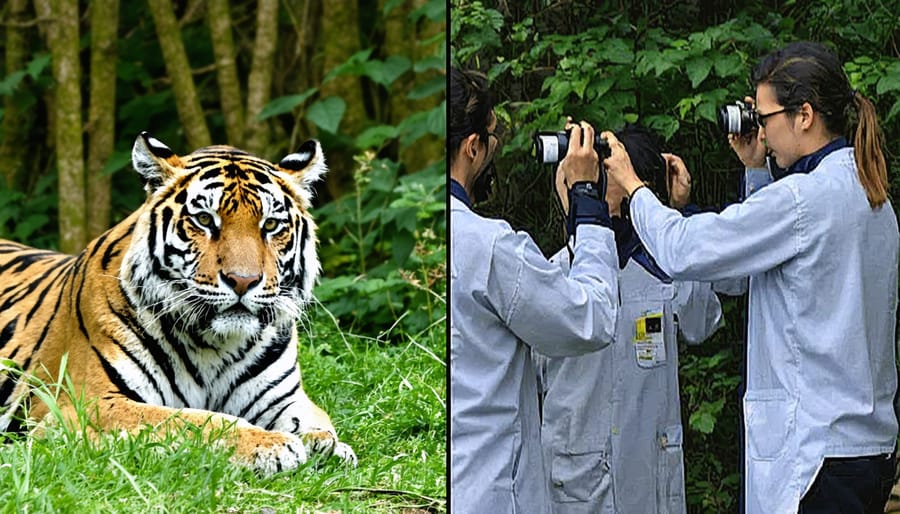
Raising Awareness
Wildlife photography has emerged as a powerful tool for environmental advocacy, bridging the gap between distant wildlife and the public consciousness. Through compelling images, photographers can tell stories that words alone cannot convey, creating emotional connections between viewers and the natural world. These visual narratives often become catalysts for conservation action, inspiring people to protect species and habitats they might never encounter firsthand.
Social media platforms have amplified this impact, allowing wildlife images to reach millions of viewers instantly. A single photograph of an endangered species in its natural habitat can spark conversations about conservation, habitat loss, and human impact on the environment. Additionally, wildlife photography contests have become instrumental in highlighting critical environmental issues while celebrating the beauty of our natural world.
Conservation organizations increasingly rely on wildlife photography to document threatened species, demonstrate the effects of climate change, and showcase successful protection efforts. These images serve as powerful educational tools, helping to secure funding for conservation projects and influence policy decisions. They also play a crucial role in scientific research, providing visual evidence of animal behavior, population dynamics, and ecosystem health.
Through their lenses, wildlife photographers become advocates for the voiceless, transforming casual observers into passionate supporters of wildlife conservation. Their work reminds us of our responsibility to protect and preserve the incredible diversity of life on our planet.
Essential Skills for Conservation Photography
Field Craft and Animal Behavior
Successfully capturing wildlife in their natural habitat requires more than just technical camera skills – it demands a deep understanding of animal behavior and expert fieldcraft techniques. Wildlife photographers must become naturalists, learning to read animal body language, predict movement patterns, and recognize behavioral cues.
Understanding your subject’s daily routines is crucial. Many animals are most active during dawn and dusk, known as the “golden hours.” Learning migration patterns, feeding habits, and breeding seasons helps photographers anticipate where and when to find their subjects. For instance, knowing that certain bird species display courtship behaviors in early spring can lead to capturing spectacular moments.
Fieldcraft involves developing skills to approach wildlife without causing disturbance. This includes reading wind direction to prevent your scent from alerting animals, moving slowly and deliberately, wearing appropriate camouflage, and utilizing natural cover. The key is becoming part of the landscape rather than an intrusive presence.
Patience is perhaps the most vital attribute in wildlife photography. Sometimes, photographers spend days or weeks waiting for the perfect moment. Building permanent or temporary hides can help you remain undetected while observing natural behavior. Many successful wildlife photographers keep detailed field notes about animal movements and behaviors, creating valuable references for future shoots.
It’s essential to recognize signs of stress in animals and maintain a respectful distance. Understanding threat displays and alarm calls helps photographers avoid causing disturbance. The welfare of the subject should always take precedence over getting the shot. This ethical approach not only protects wildlife but often results in more authentic and compelling images that showcase natural behavior.
Storytelling Through Images
Wildlife photography goes beyond simply capturing animals in their natural habitat – it’s about telling compelling visual stories that connect viewers with the natural world. The most impactful wildlife images combine technical excellence with narrative elements that evoke emotion and understanding.
To create meaningful narratives through your wildlife photos, focus on capturing behavioral moments that reveal something about the animal’s life – a mother nurturing her young, predators hunting, or unique interactions between species. Environmental context is crucial – include habitat elements that show how the animal lives and survives in its ecosystem.
Composition plays a vital role in storytelling. Use techniques like leading lines to draw viewers into the scene, or frame your subject to highlight its relationship with its surroundings. Consider the emotional impact of different perspectives – eye-level shots create intimacy, while wider angles can demonstrate scale and habitat.
Light and timing are powerful narrative tools. Dawn and dusk not only provide beautiful golden light but often capture animals during their most active periods. Weather conditions can add drama and context – a snow leopard in a blizzard tells a different story than one on a clear day.
Remember that successful wildlife storytelling requires patience and observation. Take time to understand your subject’s behavior patterns and anticipate meaningful moments before they happen. This preparation allows you to capture authentic stories that advocate for wildlife conservation through your lens.
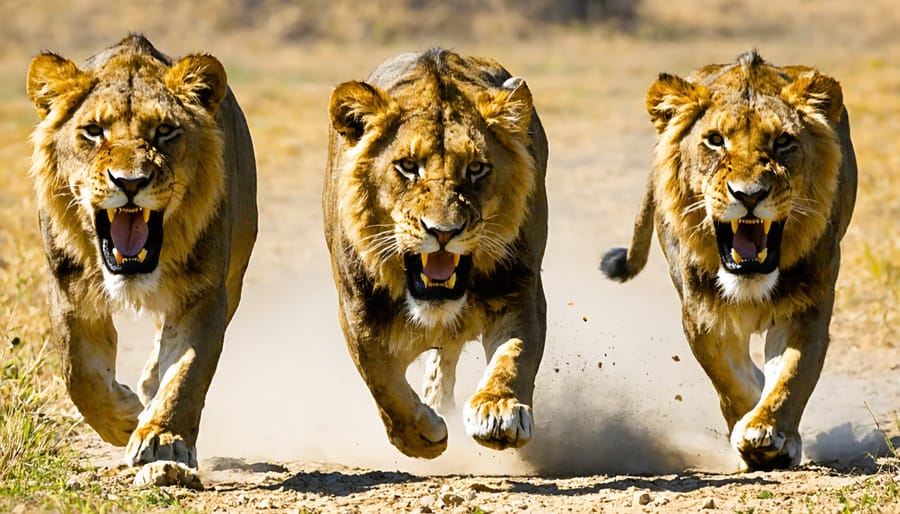
Getting Started in Wildlife Conservation Photography
Building Your Portfolio
Building a compelling wildlife conservation portfolio requires thoughtful curation and a clear narrative that showcases both your technical skills and commitment to conservation. Start by organizing your work into distinct categories such as endangered species, habitat documentation, and animal behavior. This helps potential clients and conservation organizations understand your expertise and specialization.
Include images that tell complete stories about conservation efforts, not just isolated beautiful shots. For example, capture sequences showing animals in their natural habitat, their interactions with human development, or ongoing conservation projects. Remember to document your work in challenging weather conditions, as this demonstrates your dedication and technical proficiency.
Consider creating themed collections that highlight specific conservation issues. This might include a series on local endangered species, the impact of climate change on wildlife habitats, or successful conservation initiatives. Each collection should be accompanied by detailed captions explaining the conservation context and significance of the images.
Maintain a balance between aesthetic appeal and documentary value. While stunning photographs catch attention, images that document critical conservation moments or behaviors are equally important. Include both wide environmental shots showing habitats and intimate portraits of individual animals to provide a comprehensive view of your subject matter.
Remember to regularly update your portfolio with recent work and remove dated images. This keeps your collection fresh and demonstrates your ongoing commitment to wildlife conservation photography.
Connecting with Conservation Organizations
Connecting with conservation organizations is a vital step in making your wildlife photography more meaningful and impactful. Many organizations actively seek photographers to document their conservation efforts, monitor wildlife populations, and raise awareness about endangered species.
Start by researching local wildlife sanctuaries, national parks, and environmental NGOs in your area. These organizations often welcome volunteer photographers who can help document their work and the species they protect. The World Wildlife Fund (WWF), National Geographic, and Conservation International frequently collaborate with wildlife photographers for their campaigns and research projects.
Social media platforms like Instagram and LinkedIn can be powerful tools for networking with conservation groups. Follow relevant organizations, engage with their content, and share your work using conservation-focused hashtags. Many successful wildlife photographers have built strong relationships with organizations through consistent online engagement before moving to formal collaborations.
Consider joining photography associations that focus on conservation, such as the International League of Conservation Photographers (iLCP) or the North American Nature Photography Association (NANPA). These organizations offer networking opportunities, workshops, and potential assignments for conservation projects.
Remember to approach organizations professionally, with a well-curated portfolio showcasing your wildlife photography skills. Many photographers start by offering their services pro bono to build relationships and gain experience in conservation photography. As you develop these connections, you’ll find opportunities to contribute to meaningful projects while advancing your career in wildlife photography.
Wildlife photography is more than just capturing stunning images of animals in their natural habitat – it’s a powerful tool for conservation and environmental awareness. Through your lens, you have the unique ability to tell compelling stories that can inspire change and promote the protection of our planet’s diverse species and ecosystems.
As we’ve explored throughout this article, successful wildlife photography requires a combination of technical expertise, patience, ethical practices, and a deep respect for nature. Whether you’re photographing birds in your backyard or documenting endangered species in remote locations, every image has the potential to make a difference in conservation efforts.
By sharing your wildlife photographs through social media, exhibitions, or conservation organizations, you can help raise awareness about threatened species, habitat loss, and environmental challenges. Your images can educate viewers about animal behavior, spark emotional connections with wildlife, and motivate others to support conservation initiatives.
Consider partnering with local conservation groups or contributing your images to wildlife databases and research projects. Even as a beginner, your photographs can provide valuable documentation of species populations and behaviors, contributing to scientific understanding and conservation strategies.
Remember that wildlife photography is an ongoing journey of learning and discovery. Start small, practice regularly, always prioritize the welfare of your subjects, and stay committed to ethical photography practices. Together, we can use the power of photography to protect and preserve our planet’s remarkable wildlife for future generations.

